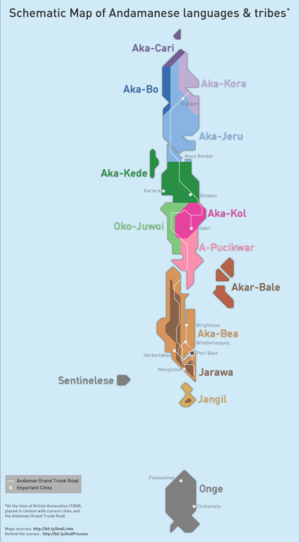加洛瓦語
加洛瓦語(Järawa、Jarwa)是一種翁奇語系語言,由加洛瓦人使用,分布在拉特蘭島內部及中南部、南安達曼島中部內陸及南部內陸、中安達曼島西海岸。[4]
| 加洛瓦語 | |
|---|---|
| Jarawa | |
| Aong ॳङ् | |
| 發音 | [əŋ] |
| 母語國家和地區 | |
| 區域 | 安達曼群島;拉特蘭島內部及中南部、南安達曼島中部內陸及南部內陸、中安達曼島西海岸,70km2的保護區。 |
| 族群 | 加洛瓦人 |
母語使用人數 | 266,民族人口的70% (2001–2002)[1] 母語者識字率:低於1% |
| 語系 | 翁奇語系
|
| 文字 | 無書面文字,有時用天城文轉寫。 |
| 語言代碼 | |
| ISO 639-3 | anq |
| Glottolog | jara1245[2] |
| ELP | Jarawa |
 | |
| 瀕危程度 | |
| 聯合國教科文組織認定的瀕危語言[3] 脆弱(UNESCO) | |
Järawa在阿卡-比語中意為「外國人」,是他們傳統敵人的語言。與世界上許多民族相仿,他們自稱為「人民」aong.
歷史
編輯加洛瓦語主要由生活在安達曼-尼科巴群島西海岸的狩獵採集人群使用。[4]
加洛瓦人是安達曼群島中僅存的尼格利陀人殘餘。他們不僅是傳統的漁獵者,還被譽為勇士與不屈的領土捍衛者。加洛瓦人作為部落實體,在遭受外來疾病的襲擾後仍然存在。[5]
加洛瓦人目前剩下約270人,他們面臨的主要威脅是安達曼幹線公路,穿過他們的領地和1028 km2的常綠林保護區。[6]
加洛瓦人的祖先被認為是首次遷出非洲的人類的後代。如今,安達曼群島上仍維持著多樣性,島上居住著數十萬印度移民。[6]
官方地位
編輯加洛瓦語是印度,特別是安達曼群島的官方語言。
音系
編輯加洛瓦語有兩種方言,分別分布在中安達曼島北部和中安達曼島南部。[7]
加洛瓦語有28個輔音和13個元音。[4]加洛瓦語、翁奇語,可能還有哨兵島語都從原始翁奇語分化而來,因此在文化和語言上有相似特徵。[8]
元音
編輯| 前 | 央 | 後 | |
|---|---|---|---|
| 閉 | i | u | |
| 半閉 | e | ɘ | o |
| 中 | ə | ||
| 開 | a |
加洛瓦語元音有圓唇不圓唇和長短之分,可分為3組:
- 前元音 - [i]、[e]
- 後元音 - [u]、[o]
- 央元音 - [ɘ]、[ə]、[a]
半低元音[ɛ]、[ɔ]的音系地位不明,極為少見。[4]
輔音
編輯| 雙唇音 | 齒音 | 齒齦音 | 捲舌音 | 硬齶音 | 軟齶音 | 喉音 | ||||
|---|---|---|---|---|---|---|---|---|---|---|
| 普通 | 唇化 | 普通 | 唇化 | |||||||
| 鼻音 | m | n̪ | ɲ | ŋ | ||||||
| 塞音 | 清 | p | t̪ | ʈ | c | k | ||||
| 濁 | b | d̪ | ɖ | ɟ | ɡ | |||||
| 送氣 | t̪ʰ | ʈʰ | cʰ | kʰ | kʰʷ | |||||
| 擦音 | ɸ | ʃ | ħ | ħʷ | ||||||
| 顫音/閃音 | r | ɽ | ||||||||
| 近音 | w | l | (ɭ) | j | ||||||
特徵
編輯詞首的/p/>/b/正在發生(注意翁奇語沒有/p/)。[9]
/c/在派生環境,在元音間會濁化;/ə/後跨語素接元音會刪略;/ə/的下一個音節有圓唇元音時會變成[o];在快速言語中整個音節可能刪除。[9]
語法
編輯詞法
編輯加洛瓦語有前後綴。前綴有兩種:
- 動詞、形容詞、名詞的代詞性前綴
- 表示定義或定指性的前綴,僅用於動詞
後綴的目的是:加在名詞上表複數;加在動詞上表語氣、情態與有證性;加在形容詞上表狀態或有證性。[4]
加洛瓦語中,語素可以使獨立存在的自由詞根,如/napo/「魚」;也可以是與強制性前綴共現的有界詞根,如/ən-oɖə/「頭髮」。/ən-ətəhə/「坐」這樣的動詞也可以是有界詞根。「頭髮」之類名詞性詞根和「坐」之類動詞性詞根若主體是人,就不能獨立出現。有界詞根須以某種語素為前綴。[4]
加洛瓦語有6種詞性:
- 名詞
- 動詞
- 代詞
- 形容詞
- 副詞
- 後置介詞
名詞、動詞、形容詞與副詞是開放詞類,名詞和動詞比較豐富,形容詞和副詞數量較少。後置介詞和代詞是封閉詞類,數量較少。各類詞的數量遞增順序:後置介詞、代詞、副詞、形容詞、動詞、名詞。
代詞有3種:人稱代詞、指示代詞與疑問代詞。人稱代詞的第一人稱為'mi',第二人稱為'ŋi ~ ni ~ ən',第三人稱為'ħi ~ əħi'。[4]
句法
編輯加洛瓦語有兩種不同的從句結構:無動詞從句,當中以名詞或形容詞作為謂語的首部;以及動詞從句,以動詞作為謂語的首部,並帶有核心論元。兩種從句都有不同的形態與句法結構。[4]
一般疑問句以ka開頭。結構為:ka + [主語] + [賓語] + [動詞]。
/Onəħə-le/可以表示「正在做什麼」或「為什麼」,/ŋi onəħə-le/「你在做什麼」,以及/ŋi onəħə-le ɖ-iche/「你為什麼這麼做」。[4]
書寫系統
編輯加洛瓦語沒有書寫系統。在觀察到的圖案中,波浪線代表大海,只能通過繪畫或圖片進行交流。[5]邁索爾CIIL為加洛瓦語引入了修訂的天城文和拉丁字母以書寫。[10][11]
| 詞義 | 發音 |
|---|---|
| 黑 | /ħiɽu/ |
| 熱 | /ħulu/ |
| 回家 | /unnə/ |
| 月 | /tape/ |
| 好 | /tapo/ |
| 蛇 | /topo/ |
| 水源 | /ħʷawə/ |
| 野豬 | /ħʷəwə/ |
| 我(們)在走 | /mi bəɘʈʰe-jə/ |
| 我(們)睡覺 | /mi omoħə/ |
| 我看見你了 | /mi ŋ-əjojəba/ |
親屬詞
編輯| 詞義 | 發音 |
|---|---|
| 父 | /ummə/ |
| 母 | /kaja/ |
| 丈夫 | /a:gi/ |
| 妻子 | /əŋa:p/ |
| 姐姐 | /a:mi/ |
| 哥哥 | /a:pə/ |
| 子女 | /ajə/ |
| 弟弟/妹妹 | /aikʰwaʈə/ |
參考文獻
編輯- ^ Paty, Chittaranjan Kumar. Forest, Government, and Tribe. Concept Publishing Company. 2007: 102 [2023-11-30]. ISBN 9788180694066. (原始內容存檔於2022-08-26).
- ^ Hammarström, Harald; Forkel, Robert; Haspelmath, Martin; Bank, Sebastian (編). Jarawa (India). Glottolog 2.7. Jena: Max Planck Institute for the Science of Human History. 2016.
- ^ UNESCO Atlas of the World's Languages in danger, UNESCO
- ^ 4.00 4.01 4.02 4.03 4.04 4.05 4.06 4.07 4.08 4.09 Kumar, Pramod. Descriptive and typological study of Jarawa (學位論文). 2012 [2023-11-30]. S2CID 60302041. (原始內容存檔於2023-02-12).
- ^ 5.0 5.1 Sreenathan, M.; Rao, V. R.; Bednarik, R. G. Palaeolithic Cognitive Inheritance in Aesthetic Behavior of the Jarawas of the Andaman Islands. Anthropos. 2008, 103 (2): 367–392. JSTOR 40467418. doi:10.5771/0257-9774-2008-2-367.
- ^ 6.0 6.1 Jarawa History (PDF). [2017-02-10]. (原始內容 (PDF)存檔於2020-10-29).
- ^ Abbi, Anvita. A Grammar of the Great Andamanese Language: An Ethnolinguistic Study (PDF). BRILL. 2013 [2023-11-30]. ISBN 978-90-04-24612-6. doi:10.1163/9789004246126. (原始內容存檔 (PDF)於2023-05-22).
- ^ Zide, Norman; Pandya, Vishvajit. A Bibliographical Introduction to Andamanese Linguistics. Journal of the American Oriental Society. October 1989, 109 (4): 639–651. JSTOR 604090. doi:10.2307/604090.
- ^ 9.0 9.1 9.2 Blevins (2007:161頁)
- ^ CIIL, Jarawa Handbook. 2000.
- ^ Omniglot, Jarawa Alphabet. [2023-11-30]. (原始內容存檔於2023-08-02).
書目
編輯- Blevins, Juliette, A Long Lost Sister of Proto-Austronesian? Proto-Ongan, Mother of Jarawa and Onge of the Andaman Islands, Oceanic Linguistics, 2007, 46 (1): 154–198, S2CID 143141296, doi:10.1353/ol.2007.0015
- Kumar, Pramod. Descriptive and typological study of Jarawa (學位論文). 2012 [2023-11-30]. S2CID 60302041. (原始內容存檔於2023-02-12).
- "Jarawa." Database for Indigenous Cultural Evolution. 1-8. Web.
- Conant, Francis P. Jarawa Kin Systems of Reference and Address: A Componential Comparison. Anthropological Linguistics. 1961, 3 (2): 19–33. JSTOR 30022298.
- Sreenathan, M.; Rao, V. R.; Bednarik, R. G. Palaeolithic Cognitive Inheritance in Aesthetic Behavior of the Jarawas of the Andaman Islands. Anthropos. 2008, 103 (2): 367–392. JSTOR 40467418. doi:10.5771/0257-9774-2008-2-367.
- Zide, Norman; Pandya, Vishvajit. A Bibliographical Introduction to Andamanese Linguistics. Journal of the American Oriental Society. October 1989, 109 (4): 639–651. JSTOR 604090. doi:10.2307/604090.
- Sarkar, S. S. The Jarawa of the Andaman Islands. Anthropos. 1962, 57 (3/6): 670–677. JSTOR 40455833.
- Abbi, A. (2013). A Grammar of the Great Andamanese Language: An Ethnolinguistic Study.
- Earl, George Windsor. 1853. The Native Races of the Indian Archipelago: The Papuans. (The Ethnographical Library, I.) London: Hippolyte Bailliere. 140pp.
- William Marsden. 1834. On the Polynesian, or East-Insular languages. In Miscellaneous Works, 1-117. London: Parbury, Allen and Co.
- Sreenathan, M. 2001. The Jarawas: Language and Culture. Calcutta: Anthropological Survey of India, Government of India. 108pp.
- R. Senkuttuvan. 2000. The Language of the Jarawa (Phonology). Calcutta: Anthropological Survey of India, Government of India. iv+56pp.
- Richard C. Temple. 1903. Languages. In The Andaman and Nicobar Islands, 96-138. Calcutta: Superintendent of Government Press.
- Nair, V. S. 1979. A note on the language of Jarawas. Bulletin of the Anthropological Survey of India 28. 17-38.
- R. S. Mann. 1973. Jarawas of Andaman - An analysis of hostility. Man in India 53. 201-220.
- Cipriani, Lidio. 1959. The Jarawa Problem. Bulletin of the Bihar Tribal Research Institute, Ranchi 1. 43-55.
- R. H. Colebrooke. 1795. On the Andaman Islands. Asiatick Researches 4. 385-395.
- P. C. Coomar. 1994. Jarawa. In T. N. Pandit and B. N. Sarkar (eds.), Andaman and Nicobar Islands, 81-86. Madras: Anthropological Survey of India.
